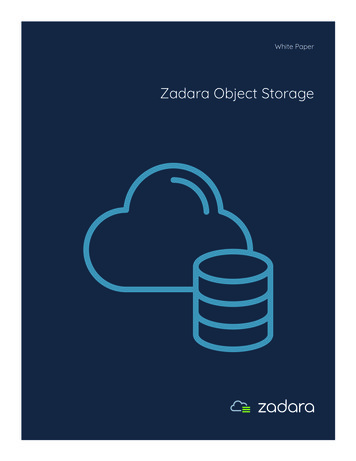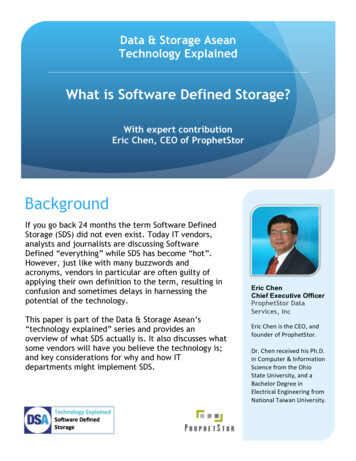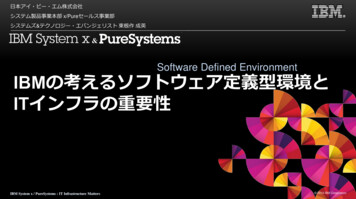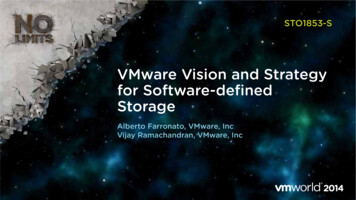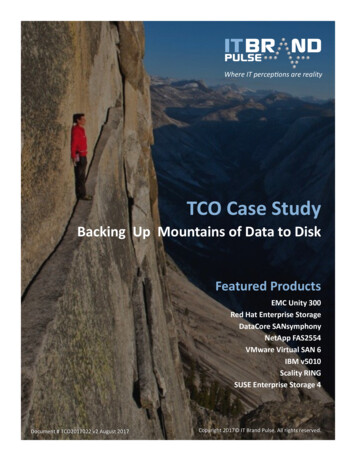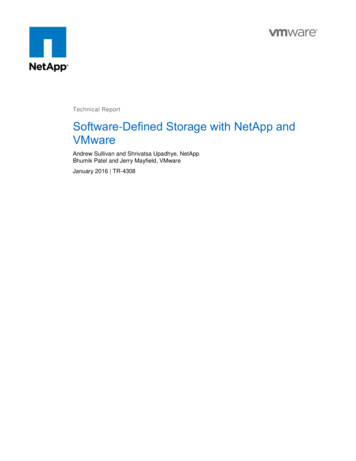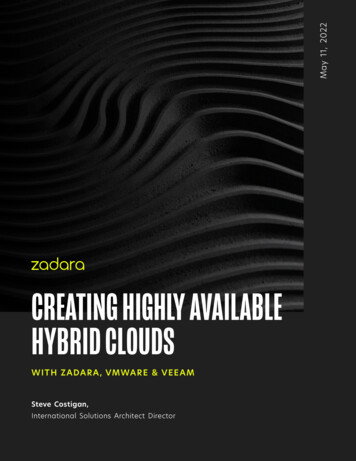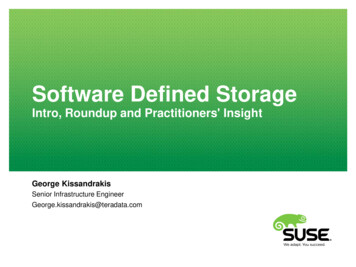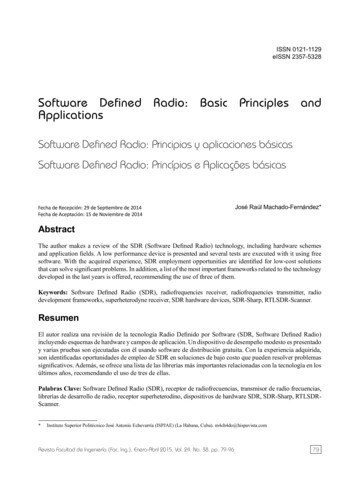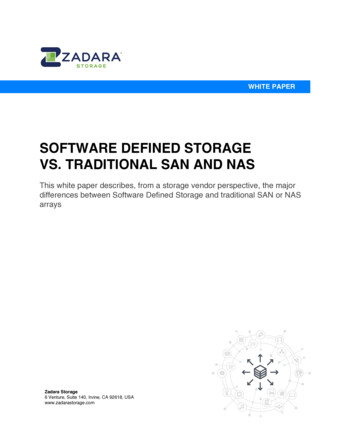
Transcription
WHITE PAPERSOFTWARE DEFINED STORAGEVS. TRADITIONAL SAN AND NASThis white paper describes, from a storage vendor perspective, the majordifferences between Software Defined Storage and traditional SAN or NASarraysZadara Storage6 Venture, Suite 140, Irvine, CA 92618, USAwww.zadarastorage.com
EXECUTIVE SUMMARYThere is a new trend of Software Defined “Everything” in IT, and the storage industryis going through the same transformation. While there is a lot of marketing buzzaround the term Software Defined Storage, this article is intended to introduce clarityby describing—from a storage vendor perspective—the major differences betweenSoftware Defined Storage and traditional SAN or NAS arrays.SOFTWARE VS. HARDWAREThis is the most obvious difference, and it has a big impact on both the cost andagility of deployment of storage systems.COSTOn the cost side, traditional SAN and NAS storage array vendors spend a lot ofmoney in developing custom ASICs, custom circuit boards and custom real timeoperating systems (OSs). A custom ASIC can cost between 10M and 20M indevelopment that, in turn, needs to be paid for via inclusion in the price of thestorage array. In fact, only a minimal part of the R&D expenses of a traditionalstorage vendor is spent on storage functionality. The majority is spent ondevelopment of custom hardware and software infrastructure. In addition, becauseall the components are proprietary, traditional storage vendors need to spend a lot ofmoney on interoperability tests. As an example, a simple new drive qualificationcycle can cost millions of dollars and take many months.On the other hand, Software Defined Storage companies use standard x86hardware and standard OSs. This means that the semiconductors used aredesigned by companies such as Intel, Broadcom and LSI. The hardware andinteroperability is completed by companies such as Dell, HP and IBM. And the OScomponents are developed by Microsoft, VMware or Linux developers. This alsomeans that a company like Zadara Storage can leverage existing and proventechnologies and concentrate all its R&D efforts purely on storage functionality,bringing forth a better product at a fraction of the cost of a traditional SAN or NASstorage array.If so, why do SAN and NAS storage array vendors prefer custom hardware? If youask any storage vendor why they need expensive custom hardware they will tell you1
that the reliability of their hardware is much better than that of standard x86hardware. In general this is true, but the other side of the same coin is that theirlegacy software assumes a great degree of reliability from the underlying hardware.Their software protects against rare “single points of failure” as opposed to multipleand more frequent failures that could happen with commodity hardware.Unlike storage based on legacy software, Software Defined Storage companies likeZadara Storage actually assume that hardware is unreliable, and the software is theone that needs to continue operating in the face of concurrent hardware failures. Byunderstanding that eventually all hardware will fail (even proprietary hardware), andarchitecting a software-defined solution with no single point of failure, SDS solutionscreate a more resilient and reliable solution than traditional proprietary arrays.AGILITYThe benefits do not end with cost savings. The other big advantage that SoftwareDefined Storage provides is agility. Agility means doing things faster; preferablymuch faster. Agility is a significant value-add because it allows rapid, effectiveresponse to changing business requirements or conditions, In fact, agility can beeven more important than cost savings.For instance, while deploying a traditional storage array can take weeks from themoment of the decision to buy to the moment it is actually installed and connected tothe application servers, the exact same thing takes exactly one minute with ZadaraStorage. “Yes”, we said, “weeks versus a minute”!Moreover, another component of the agility is automation. While traditional SAN andNAS arrays use command line interfaces (CLIs) or the SMI-S API to automatecertain operations, Software Defined Storage typically uses REST APIs that aremuch simpler to use and integrate.SCALABILITYBeyond hardware vs. software, there are other major differences between SoftwareDefined Storage and traditional SAN and NAS arrays. One of the most importantones is scalability. Traditional SAN arrays are based on a dual controllerconfiguration, and even the ones that “scale out” can scale to a maximum of about2
16 controllers. This means that there is a real limit to the number of drives one canattach behind those controllers. When using solid state drives (SSDs), this scalabilitylimit is dramatically lower due to the high IOPS (input/output operations per second)rate of the drives compared to the IOPS rate supported by the controllers. On theother hand, Software Defined Storage is designed like the cloud. It assumeshundreds to thousands of nodes (or more), interconnected with standard networks.This means that the number of drives you can put behind it is practically unlimited,even when using SSDs.From a software architecture perspective there is a world of difference betweendesigning a distributed system that can scale up to a dozen or so nodes and onethat can scale up to thousands of nodes. In the case of the latter system, one has toassume that there are no blocking activities. Different components can be up ordown at any given time and the software cannot rely on specific modules being up ordown. There is no such a thing as a “shutdown” or “reboot” of the entire storagesystem, even for a software upgrade. Software upgrades need to be performed on arolling basis, and the software needs to assume that at any given time differentnodes will have different versions of the software (and, as mentioned earlier, thatsome nodes will be down).RELIABILITYAs discussed previously, traditional SAN and NAS vendors base their availability onthe reliability of their custom hardware, while for Software Defined Storage vendorsthe reliability comes from the software—which assumes that hardware will fail,especially in highly scalable environments. It is the job of the software to make sureeverything continues to work with intelligent, self-healing processes. This differencein concept actually makes the Software Defined Storage systems much morereliable than traditional SAN and NAS storage devices. This kind of thinking is whatmade technologies like the Internet and its underlying protocol, TCP/IP, very reliable.Much in the same way, TCP/IP assumes that routers will fail between two points buthas enough intelligence to reroute packets via alternate routes—resulting inresiliency and reliability.MULTI-TENANCY3
Because the traditional SAN and NAS storage devices are limited in scalability, theyusually serve a single purpose, and typically only one administrator or a very limitednumber thereof. There is no good separation among workloads in a SAN or NASstorage array that is shared by multiple applications. This causes performanceproblems and lack of self-provisioning by the applications. Typically, customers buymultiple storage arrays and employ physical separation among workloads.Obviously, this is not cost effective, as unused space in one storage array cannot beused by another array. It is also not efficient for storage administrators, who need tomanage multiple storage arrays, which they purchase, at times, from differentvendors and have different management consoles.On the other hand, a Software Defined Storage system is built with multi-tenancy inmind. The ability to separate workloads and even self-provision storage by everytenant is critical if all the storage for all the applications is to come from a singlesystem. This allows isolation of the performance among tenants and at the sametime allows the user to quickly reallocate unused storage to other applications orother tenants.Another aspect of multi-tenancy is chargeback. Most of the traditional SAN and NASarrays lack the ability to track the usage and cost of particular applications, while in amulti-tenant environment, it is important to understand the cost incurred by everytenant. Software Defined Storage designed for the cloud, such as the VPSA Storage Array by Zadara Storage, has metering and billing capabilities built inproviding users the ability to charge-back to various departments based on usage,rather than a flat CapEx percentage.SUMMARYBehind the marketing buzz of Software Defined Storage there is real substance.Real Software Defined Storage delivers significant cost savings, unprecedentedagility, cloud scale, and multi-tenancy. Storage that falls short of these criteria is notsoftware defined. It may talk the talk, but it doesn't walk the walk.4
CONTACT USUSA Salessales@zadarastorage.com 1-949-251-0360International Salessales@zadarastorage.comz 44-1285-61004524/7 Supportsupport@zadarastorage.com 1-949-284-0713 2017 Zadara Storage. All rights reserved.Company or Product names may be the property of their respective owners.FEB0920175
Software Defined Storage designed for the cloud, such as the VPSA Storage Array by Zadara Storage, has metering and billing capabilities built in providing users the ability to charge-back to various departments based on usage, rather than a flat CapEx percentage. SUMMARY Behind the marketing buzz of Software Defined Storage there is real .
